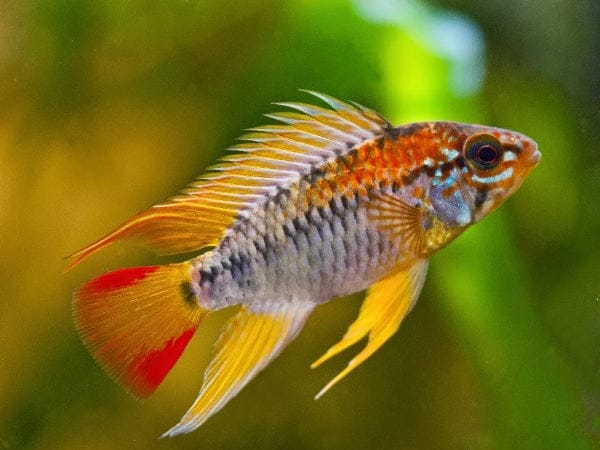Wild Exotic Bettas
Double Red Agassizi's Dwarf Cichlid (Apistogramma cf. agassizii)
Double Red Agassizi's Dwarf Cichlid (Apistogramma cf. agassizii)
Couldn't load pickup availability
Share
This variety is one of the most colorful and popular of the superspecies!
The Double Red Agassiz's Dwarf Cichlid (Apistogramma cf. agassizii) is an extremely colorful variant of this superspecies. Adult males have a great deal of red finnage as well as blue, violet, and yellow coloration along the body! As with most dwarf cichlids, adult females are less colorful by comparison, but still have a good amount of coloration (particularly yellow and black with some red/orange highlights) and have an attractive appearance with plenty of personality.
The Double Red Agassizi's Dwarf Cichlid will thrive in an aquarium with a sandy substrate and plenty of refuge such as clay pots, driftwood, and rock formations. It is an excellent candidate for the planted aquarium, but it also needs a fair amount of open space. This cichlid is generally compatible with other peaceful fish as long as it has plenty of room. Territoriality is typically at its peak during spawning. Dwarf shrimp and other small, delicate invertebrates should not be kept with the Double Red Agassizi's Dwarf Cichlid, but more durable, larger shrimp and snails could possibly make good tankmates in a large enough aquarium. If spawning is desired, tankmates of other species should be kept to a minimum or avoided altogether.
Feeding is simple for the unfussy Double Red Agassizi's Dwarf Cichlid. High-quality dry, frozen, and live meaty foods will all be readily accepted. Quality and variety are the keys to a diet that will ensure that this fish maintains optimal health and coloration.
What We Like About This Fish:
- Beautiful coloration
- Hardy with plenty of personality
- Possible to breed in the aquarium
- Compatible with many other species in a spacious tank
- Will not bother most ornamental plants
RECOMMENDED TANK PARAMETERS:
- Temperature: 72° - 84° F (22° - 29° C)
- pH: 5.0- 7.0 for tank-raised specimens
- KH: 2 – 15 KH
- Minimum tank size: 20 gallons for a pair, but a larger tank is required for a group
CARE GUIDELINES:
- Diet: Carnivorous. A variety of high-quality dry, frozen, and live meaty foods is necessary for optimal health and coloration.
- Social behavior: Congregates loosely in groups. Males can be territorial when attempting to spawn and females are very protective of their eggs during spawning.
- Origin: Tank-bred, but indigenous to Rio Tefe South America
- Average adult size: 3 inches (7.5 cm) for males, 2 inches (5 cm) for females
- Average purchase size: 1.5 – 2 inches (3.8 – 5.1 cm)



